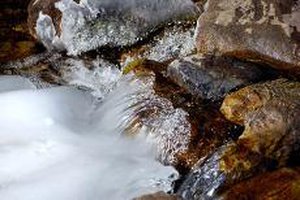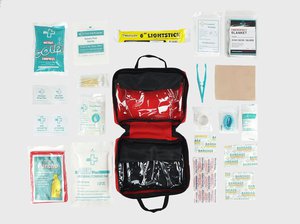Survival Basics
Updated
Having a bug out bag ready to go filled with useful items and supplies is a good start towards being prepared for emergencies, but it does not necessarily guarantee your survival. No matter how many cans of food you stockpile or nifty tools you pack away, if you do not develop a survival mindset, you might end up falling victim to your situation. In order to avoid this fate, make sure to develop the ability to calmly assess your situation and apply different methods and strategies based on what best suits your circumstances. For instance, you need to stay calm and consider all of your options in order to figure out where to go and which evacuation route to take. If you just jump in your vehicle and start driving, you might end up heading towards a blocked road burning through fuel and wasting time you will desperately need, to get to safety. So it is imperative you learn not to panic and be confident in your knowledge of survival basics.
It is also important to realize that you simply cannot prepare for every single emergency and eventuality. Rather, you should aim for developing flexibility in applying your experience and skills across the board so that you have a basic working knowledge of the most important actions you can take to help you survive. For these reasons, you must always take a small amount of time to stop and review your situation, look at your available options, asses them, and make plans accordingly. The three major key elements of survival can be summed up in building a shelter, making sure you stay healthy and able to care for any health problems, and finding resources for your sustenance, such as food and water.
Shelter
Whether you need to survive the tropics or in Arctic climates or anything in between, you will need to have a shelter during your evacuation. Ideally, you would have a light tent packed in your bug out gear, but you should also practice building a shelter out of material you can find in the wild. This will not only serve as a base camp where you can store your supplies and gear, but it will also provide you with essential protection from the elements. Even in moderate climates, sun exposure can be perilous, just as much as hypothermia. It is very difficult to gauge how much direct sunlight you are able to tolerate without negative effects, and often you realize the problem only after it had happened. Overexposure might lead to sun burns, dehydration, and sun stroke. Similarly, your shelter will be a major part of your protection against cold, as it will allow you to concentrate your heat in multiple ways.

First, you will be able to heat up even a non-airtight space with body heat from multiple people and animals, just as sharing body heat can be a good way to keep warm during the night. This is especially important as you are more likely to stretch out in your sleep, which means you are in a position that does not protect your core body heat. Secondly, having a shelter will help you use your fire’s heat the most efficiently, as you can place your emergency blanket or another piece of reflecting material behind you in order to heat both your front and back at the same time. Remember, this is an emergency shelter and not a three bedroom house you are building. You should aim for a size that can accommodate your body, or all persons in your group, and not larger. You are trying to conserve heat, and all extra space not taken up by someone producing heat is a waste of heat. So in this case, not having extra room is a good thing.
The best way to quickly put up a temporary shelter is to look at options that can provide you with a lean-to type construction. This way you will already have one wall of your shelter ready, which will give you some sturdiness. You can also use natural spaces for shelter such as caves or hollowed out areas under trees and tree trunks. If you decide to take advantage of these spaces, make sure they are unoccupied and structurally safe. Another option is to build a triangular shelter using three long poles as ridges supported by shorter branches on both sides. You can tie the poles to each other with rope and cover it with a tarp, fallen branches, moss, or leaves. Whichever way you decide to go you must always clean the floor of your shelter from debris and cover it with some sort of material such as leaves, tree bark, or grass. Without this insulation you would start losing heat from your shelter and your body very quickly.
In an emergency situation it is important to keep in mind that people have been building shelters in a great variety of environments using a wide array of materials. You simply need to stop and think for a moment before you start planning your shelter. For instance, landing on bare island with no wood means you will need to concentrate on digging a hole for a semi-sub terrain shelter or flip over your boat for instant protection from the elements. Extreme cold means you can try out your hand in building an igloo style shelter using ice and snow, etc… Lastly, building a shelter will protect you from predators, and allow you to have a good rest, which you will need it in order to get through the following hours and days safely. Even though you are aiming to preserve as much heat as possible, your shelter should never be airtight.
Water
Truth is you cannot go without water for more than three days. Naturally, this does not mean that you should go without water for that long. In fact, proper and regular hydration can go a long way in maintain your strength, mental agility and responsiveness in emergencies. An adult needs to drink an average of about one gallon of water a day under normal circumstances, but additional factors such as extreme temperatures, increased perspiration, or normal than average weight can increase this amount. Dehydration can cause you to grow weak and deteriorate your overall health very quickly so you should always strive to avoid this situation. For this reason, locating a dependable source of water should be one of the first things you do when you need to survive. Moreover, you should never let yourself run out of clean drinking water, so you will need to look for, locate, and prepare drinking water while you still have some left in your supplies. Or better yet, before there is an emergency.

You can collect drinking water in a variety of ways, as for instance from running streams, rain, or morning dew. Using a tarp or a large plastic sheet can be effective in gathering and funneling rainwater into a container as well as to collecting morning dew. It is always a good idea to have quart size plastic bags on hand particularly for the purposes of storing drinking water. You never know when you will come across another stream, so it is good to have a lightweight option for carrying some water with you.
Of course, finding water is only one side of the problem. Just as many people get in to trouble by drinking contaminated water as the number of people who suffer dehydration. You should never drink from a body of water just because it looks clean. In fact, you would do well to never drink any kind of water without purifying it through a proven process. Survival Cache has a great article on 6 Dangerous “Urban Survival Myths” About Water. First, you should filter out debris from the water with the help of a piece of clean cloth that will work as a sieve. This alone does not make your water safe to drink, so you also need to use one of the following techniques: boiling, active water filters, water tablets, or distillation. Your goal is to remove harmful bacteria and parasites from the water that are invisible, but can make you very ill. You will find a great variety of water tablets and filters available for your particular circumstances. You will need to carefully follow all directions on them in order to procure health drinking water. As for boiling, you need to make sure that you boil the water for ten minutes in order to kill off all the organisms that would be harmful to you. If you live or evacuate to higher altitudes, add an additional minute for each 1000 feet above water level. Be aware that boiling water will not remove any poisonous heavy metals or chemicals from the water that might still make you ill. So try to stay away from well-travelled waterways and aim for a pure water source. Distillation is a process that involves boiling water then allowing the vapors to condense on a clean surface. This process eliminates most impurities and provides you with clean water, it can take a lot of effort, energy, infrastructure, and time to gain enough water that will keep you hydrated.
Food
Both food and water are essentials to your sustenance, and in an emergency situation you will need to start a fire to have access to them both. Naturally, there are food sources that can be gathered and harvested without cooking them, but you must be very sure of yourself if you choose to do so. Cooking alone does not automatically make your food source ready for consumption, but it does cut down on the possibility of food poising due to bacteria, parasites, and other volatile organisms. Cooking, under most circumstances, will not remove poison. For this reason, you should never consume raw or undercooked meat, fish, seafood, or eggs during your evacuation. For instance, bear meat contains Trichinella parasites and if you do not know how to cook it the correct way consuming it can prove fatal. Likewise, collecting mussels and other seafood from areas that are experiencing red tide, or harmful algal blooms, for consumption will poison you very quickly and these toxins can easily be lethal. The same applies to mushrooms and other vegetation; unless you are intimately familiar with all types of them available in that particular ecological environment you need to survive in, do not collect, touch or eat them. Mushroom spores in particular can be harmful as they transfer to other types of food sources so they are capable of making you ill, even if you do not eat them directly.

For best results, you should have a field guide in your bug out bag that describes most of the edible food sources in your region. In general, harvesting small mammals, birds, eggs, and freshwater fish are good options as long as you remember to clean, process, and cook them thoroughly. Also, do not eat the meat of any animal you come across dead, as you simply cannot know with absolute certainty how old the carcass is or what had killed it. If you do not have a weapon you can use for hunting, you can easily make small snares and traps out of a piece of wire and some wood branches. With your survival knife, you can also carve out a spear for fishing. Do not attempt to follow, trap or hunt large animals unless you are an experienced hunter and have adequate weapons to efficiently kill large game. Although, it goes without saying, but it can bear repeating: do not attempt to kill animals that appear injured or sick, especially large games, even if they are herbivores. They can easily turn violent and cause you major injury. Perhaps a moose looks innocent and harmless, but it can kill you with a well-aimed kick – the best thing to do is stay clear.
Most likely, you will have some form of nourishment packed in your survival pack for evacuations, but it is good to be prepared in case you run out or get separated from your supplies. The recommended average food consumption for an adult is 2000 calories that should include proteins, fats, and carbohydrates, so it is a good idea to be prepared for being able to supply at least a part of that from your local environment even if you have ready to eat meals on hand.
Health
There are many things you can do to avoid the need for medical assistance, and there also many things that can simply happen even with the most cautions person. The idea of taking a versatile medical kit with you during evacuation is contradictory, because, of course, the reason for taking it is the hope that you will not need to use any of it. However, life happens regardless of an emergency, and you should be prepared for it. Small bruises, cuts, and punctures can be easily treated with disinfectants and bandages. One of the most important health supplies you can take with you is a generous roll of compression tape that can help you set sprains and fractures as well as stop bleeding. Even though disaster evacuations are stressful situations, try to keep your calm and follow normal procedures. Do not eat foods that will upset your stomach, do not drink alcohol, not even for Dutch courage, and try to minimize opportunities for small accidents by thinking through your actions before executing them.
Once you reach the destination of your evacuation analyze your situation and do not panic. Your main goal is to keep your body temperature steady and protect it against the elements. Excesses such as cold or heat can throw off this balance, which means more work for your system and more difficulties for you in your quest to survive. Do not overwork yourself so to avoid too much sweating that can lead to hypothermia and dehydration. Moreover, take stock of your clothing and be prepared to wear them in layers according to the activity you are doing at the moment. You should never let the layer closest to your body get wet or moist with perspiration. If it does, remove it immediately and put on dry clothing. Ideally, your clothing should be made of moisture wicking materials. Wearing these types of cloths in layers will trap air in between and help you stay warmer. In cold weather, you will need to be especially careful about concentrating your body’s core heat. You can achieve this through sitting wrapped up in an emergency blanket in order to keep your body from losing too much heat. Do not forget to move your legs from time to time to increase circulation. Even if you prepare to evacuate in a warm climate, a hat and a pair of sturdy gloves are a must. The former will protect you from the sun, UV rays, bugs, rain and wind, while the latter will help you in building and food preparation. Just by wearing gloves you can prevent many small injuries and scrapes which may lead to infections.
Lastly, do not forget to signal for help if you are in a situation you cannot get out of yourself. You can easily build three small, well contained fires and use them to draw attention to your location. During the day, throw leaves, green wood, and grass on the fires to create smoke, and you can also lay out signals for air rescue using branches or small rocks. Use your emergency kit supplies such as your whistles, mirrors, and radios to get in touch with rescue personnel or other evacuees.
Featured Articles
-

SOC Bags
SOC Bags are built to last. No matter what you are looking for SOC has you covered. Here is a review of the top bags to choose from.
-

What To Pack In Your Go Bag
72 Hour Bags are designed to keep you safe and secure for 72 hours in case there is a disaster. Find out what should be in your bag.
-

Bug Out Bags For Sale
There are many bug out bags for sale, but you need to make sure you get the right one for you. In this article we look at a few of the most popular.
Recent Articles
-

Get Home Bag
Make sure you can get home in an emergency situation with a get home bag. A get home bag is specifically designed with the gear you will need to make it home.
-

Essential Bug Out Bag Items
Just the essentials. Make sure your survival pack contains these essential bug out bag items, otherwise you may be in trouble.
-

Prepper Stocking Stuffers
Get some great stocking stuffer ideas for that prepper, survivalist, or grown-up boy scout in your life!
-

SOC Bug Out Bags
Sandpiper of California (SOC) produces high quality backpacks, find out why they may produce the best bug out bags available.
-

Prepping Definitions
Hi everybody! It’s that time again, so grab some popcorn and settle in – this week’s SignalSurvival blog post is comin’ at ya, hot and fresh off the presses. Actually, before we get into the meat and potatoes of this week’s entry, here’s a little secret for you all: While researching and writing these things … Continued
-

End of the World Balance Sheet
Did you guys hear about that PrepperCon in Utah last week? Preppers and survivalists from all over have hopped on the Comic Con bandwagon! They had exhibits on everything from tactical seat covers to personal Humvees, and the cast of AMC’s hit show THE WALKING DEAD made an appearance! How cool is that? People are … Continued
-

Bug Out Kits
Are you someone who wants a bug out bag but doesn't know what should go in it? Don't worry, there are full bug out kits to get you started.
-

Survival Weapons
Survival weapons are used for food, safety and as a utility tool. This article is all about the options available for your bugout bag.
